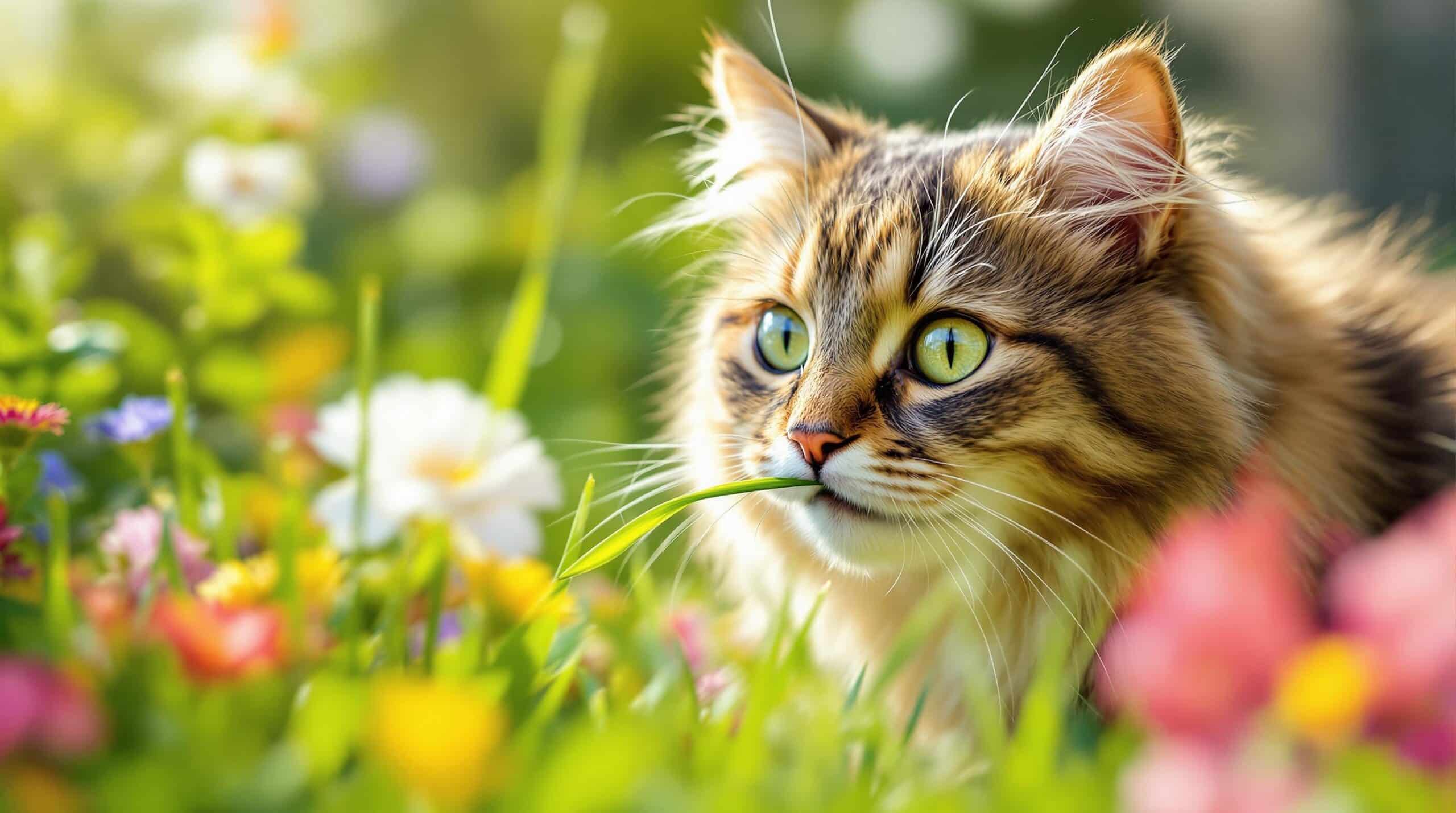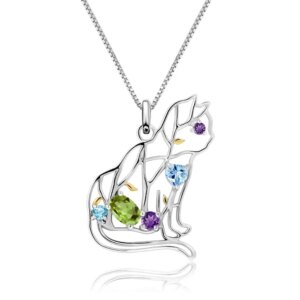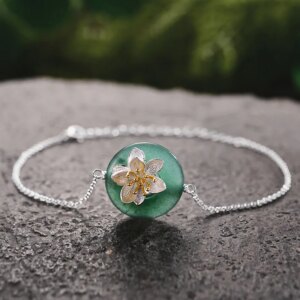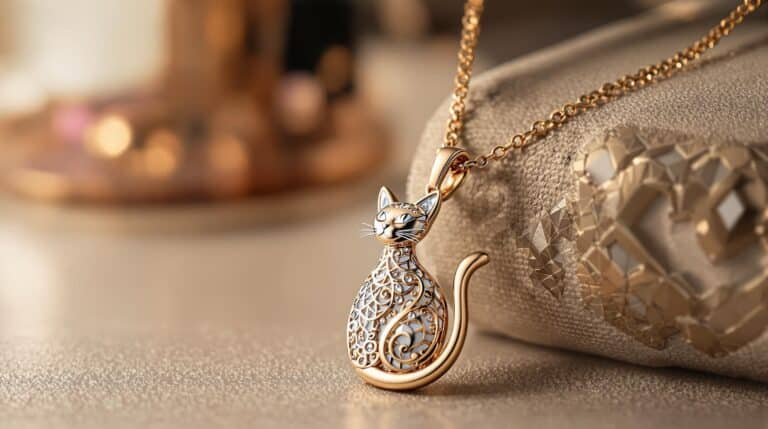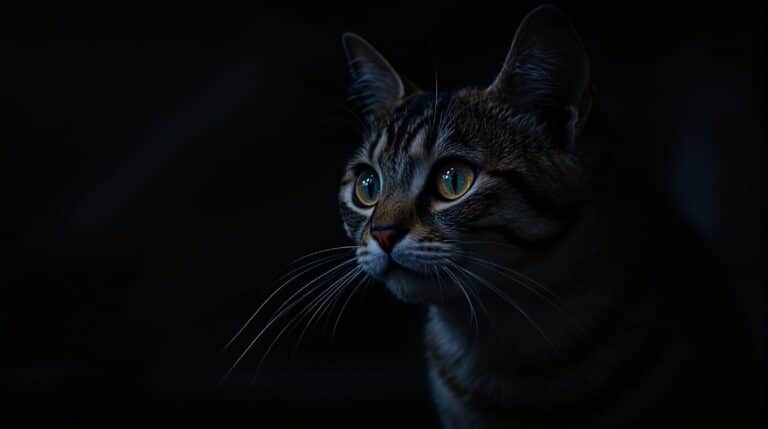Cats eating grass is a common behavior that has puzzled many pet owners. At Cat Karma Creations, we delve into the reasons behind this behavior, the potential health benefits, and the risks involved. We will explore how cat grass can support your cat’s digestion, reduce hairballs, and even alleviate anxiety. By the end, you’ll have a comprehensive understanding of why cats eat grass and how to ensure it’s safe for your feline friend. Visit our website to find unique and uplifting cat-themed jewelry and gifts.
Why Do Cats Eat Grass
Evolutionary Instincts
Cats eating grass is an ancient behavior rooted in their evolutionary past. In the wild, cats often consume small amounts of grass to aid in digestion and help expel hairballs. This instinct has been passed down to domestic cats, who may eat grass to mimic this natural behavior. Understanding these instincts can help pet owners recognize the importance of providing a safe environment for their cats to engage in this activity. At Cat Karma Creations, we believe in supporting the natural behaviors of our feline friends.
Nutritional Needs
Cat grass contains essential nutrients that can supplement a cat’s diet. These nutrients include vitamins A, C, and E, as well as folic acid and chlorophyll. While cats are obligate carnivores and derive most of their nutrients from meat, small amounts of these plant-based nutrients can support their overall health. For example, folic acid is crucial for blood health and can help prevent anemia in cats. Our cat-themed jewelry is designed to celebrate the unique bond between humans and their feline companions.
Behavioral Cues
Cats may eat grass as a way to self-medicate or alleviate discomfort. If your cat is showing signs of stress, anxiety, or digestive issues, they might turn to grass as a natural remedy. Observing your cat’s behavior can provide valuable insights into their health and well-being. For instance, if your cat is eating more grass than usual, it could be a sign that they are experiencing some form of discomfort or distress. At Cat Karma Creations, we understand the importance of a happy and healthy cat, which is why we offer a range of nature-inspired products.
Benefits of Cats Eating Grass
Aids Digestion
One of the primary benefits of cats eating grass is its ability to aid digestion. The fiber in cat grass can help move food through the digestive tract more efficiently, reducing the risk of constipation and other digestive issues. Additionally, the enzymes found in grass can help break down proteins and other nutrients, making them more easily digestible for your cat. This can be particularly beneficial for older cats who may have slower digestive systems. Our sterling silver cat jewelry is perfect for cat lovers who appreciate quality and style.
Reduces Hairballs
Another significant benefit of cats eating grass is its role in reducing hairballs. When cats groom themselves, they often ingest loose fur, which can form into hairballs in their stomach. Eating grass can help cats expel these hairballs more easily, either by vomiting or through their stool. This can prevent the formation of large, potentially dangerous hairballs that could cause blockages in the digestive system. Regular access to cat grass can help manage hairballs and keep your cat more comfortable. At Cat Karma Creations, we offer a variety of stylish cat lover necklaces that are perfect for any occasion.
Supports Dental Health
Cat grass can also contribute to your cat’s dental health. Chewing on grass can help clean your cat’s teeth and reduce the buildup of plaque and tartar. This natural action can help prevent dental issues such as gingivitis and periodontal disease, which are common in older cats. Providing your cat with access to fresh cat grass can be a simple and effective way to support their oral hygiene. Our silver cat earrings are a beautiful addition to any jewelry collection.
Alleviates Anxiety
Some cats may eat grass as a way to self-soothe and alleviate anxiety. The act of chewing on grass can be calming and may help reduce stress levels. Additionally, the nutrients in cat grass can have a mild sedative effect, which can further help your cat relax. If your cat is showing signs of anxiety, such as excessive grooming or hiding, providing them with a safe source of cat grass might help them feel more at ease. Our cat brooches are a unique and charming accessory for cat lovers.
Risks and Concerns
Toxic Plants
One of the main risks associated with cats eating grass is the potential exposure to toxic plants. Many common household and outdoor plants can be harmful to cats if ingested. It’s essential to ensure that your cat only has access to safe, non-toxic grass. Some toxic plants to be aware of include lilies, azaleas, and oleander. Always supervise your cat when they are outside and remove any potentially harmful plants from your home and garden. At Cat Karma Creations, we care about the well-being of all cats and offer a range of elegant cat brooches to show your love for felines.
Vomiting and Diarrhea
While cats eating grass can have many benefits, it can also lead to digestive issues such as vomiting and diarrhea. If your cat is eating too much grass or consuming it too quickly, they may experience these symptoms. It’s important to monitor your cat’s grass consumption and ensure they are not overindulging. If you notice persistent vomiting or diarrhea, it’s best to consult with your veterinarian to rule out any underlying health issues. Our lovely peridot crystal cat necklace is a beautiful and meaningful gift for any cat lover.
Pesticides and Chemicals
Another concern is the potential exposure to pesticides and chemicals. If your cat is eating grass from an area that has been treated with pesticides or other chemicals, they could ingest these harmful substances. Always choose organic or pesticide-free grass for your cat, and avoid letting them eat grass from areas that may have been treated with chemicals. Growing your own cat grass at home is a safe and effective way to provide your cat with a clean and healthy source of grass. Our wrap around cat ring is a unique and stylish piece of jewelry that is perfect for any cat lover.
How to Grow Cat Grass at Home
Choosing the Right Grass Type
When growing cat grass at home, it’s important to choose the right type of grass. Common options include wheatgrass, oat grass, and barley grass. These types of grass are safe for cats to consume and provide a variety of health benefits. Wheatgrass is high in chlorophyll and antioxidants, oat grass is rich in fiber and protein, and barley grass is a good source of vitamins and minerals. Consider your cat’s specific needs and preferences when selecting the type of grass to grow. At Cat Karma Creations, we offer a range of amethyst bird earrings that are perfect for nature lovers.
Planting and Care Tips
Growing cat grass at home is relatively easy and can be done using a few simple steps. Start by choosing a container with good drainage and fill it with a potting mix designed for indoor plants. Plant the grass seeds according to the package instructions, and place the container in a warm, sunny spot. Water the seeds regularly, keeping the soil moist but not waterlogged. Within a week or two, you should see the grass begin to sprout. Once the grass reaches a height of about 2-3 inches, it’s ready for your cat to enjoy. Our exquisite silver cat earrings are a beautiful and elegant choice for any cat lover.
Harvesting and Feeding
When the grass is ready, you can harvest it by cutting it just above the soil line. This will encourage new growth and ensure a steady supply of fresh grass for your cat. You can place the harvested grass in a shallow dish or directly in your cat’s food bowl. Some cats may prefer to chew on the grass directly from the container, so it’s a good idea to have multiple containers available. Regular harvesting and care will help keep your cat grass fresh and healthy. Our mystic topaz cat set is a stunning and unique gift for any cat lover.
Popular Quote
“Cats are connoisseurs of comfort.” – James Herriot
Statistical Fact
According to a study published in the Journal of Feline Medicine and Surgery, approximately 71% of cats have been observed eating grass at some point in their lives. This statistic highlights the commonality of this behavior and underscores the importance of understanding its benefits and risks. (Source: Journal of Feline Medicine and Surgery)
Three Tips for Supporting Your Cat’s Grass-Eating Habit
1. Provide a Safe Source of Grass
Ensure that your cat has access to safe, non-toxic grass. Growing your own cat grass at home is the best way to control the quality and safety of the grass your cat consumes. This can help prevent exposure to harmful plants and chemicals.
2. Monitor Grass Consumption
Keep an eye on how much grass your cat is eating. While some grass consumption is normal, excessive intake can lead to digestive issues such as vomiting and diarrhea. If you notice any unusual symptoms, consult with your veterinarian.
3. Encourage a Balanced Diet
While cat grass can provide additional nutrients, it should not replace a balanced diet. Ensure that your cat is receiving all the necessary nutrients from a high-quality, meat-based diet. Cat grass can be a supplement, but it should not be the primary source of nutrition.
Popular Questions About Cats Eating Grass
1. Is it normal for cats to eat grass?
Yes, it is normal for cats to eat grass. This behavior is rooted in their evolutionary past and can provide several health benefits, such as aiding digestion and reducing hairballs.
2. Can eating grass harm my cat?
While eating grass can be beneficial, it can also pose risks if your cat consumes toxic plants or grass treated with pesticides. Always provide a safe, non-toxic source of grass and monitor your cat’s consumption.
3. How can I grow cat grass at home?
Growing cat grass at home is easy. Choose a container with good drainage, fill it with potting mix, and plant the grass seeds according to the package instructions. Place the container in a warm, sunny spot and water regularly. Harvest the grass when it reaches a height of 2-3 inches.
4. What are the signs that my cat is eating too much grass?
If your cat is eating too much grass, they may experience symptoms such as vomiting, diarrhea, or loss of appetite. If you notice these signs, reduce their grass consumption and consult with your veterinarian if the symptoms persist.
5. Can cat grass help with anxiety?
Yes, some cats may eat grass as a way to self-soothe and alleviate anxiety. The act of chewing on grass can be calming, and the nutrients in the grass can have a mild sedative effect. If your cat is showing signs of anxiety, providing them with a safe source of cat grass might help them feel more at ease.
Final Thoughts About Cats Eating Grass
In conclusion, cats eating grass is a natural behavior that can offer several health benefits. By understanding the reasons behind it and ensuring a safe environment, you can support your cat’s well-being. If you have any concerns, always consult with your veterinarian. Visit our website to explore our range of cat-themed jewelry and gifts, perfect for any cat lover. You can also follow us on Facebook, Instagram, and Pinterest to stay updated on our latest products and promotions. If you have any questions or would like to place a custom order, feel free to contact us at info@catkarmacreations.com or call us at (800) 343-1604. We look forward to hearing from you and helping you find the perfect gift for the cat lover in your life.
| Feature | Cat Grass | Wheatgrass | Oat Grass |
|---|---|---|---|
| Nutritional Value | High in vitamins and minerals | High in chlorophyll and antioxidants | High in fiber and protein |
| Growth Difficulty | Easy to grow indoors | Moderate difficulty | Easy to grow outdoors |
| Health Benefits | Aids digestion, reduces hairballs | Boosts immune system, detoxifies | Supports dental health, reduces anxiety |
| Availability | Widely available in pet stores | Available in health food stores | Common in garden centers |
| Cost | Affordable | Slightly more expensive | Economical |
- Understand the natural instinct of cats to eat grass and its evolutionary roots.
- Learn how to identify safe grass types for your cat to consume.
- Discover the nutritional benefits of cat grass and how it supports overall health.
- Explore the role of cat grass in managing common health issues like hairballs and digestive problems.
- Find out how to grow and maintain cat grass at home for a fresh and safe supply.
- Understand the signs to watch for if your cat is eating too much grass and when to consult a vet.

